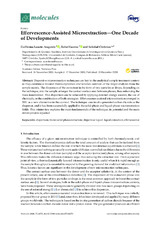Mostrar el registro sencillo del ítem
Effervescence-Assisted Microextraction—One Decade of Developments
| dc.contributor.author | Lasarte-Aragonés, Guillermo | |
| dc.contributor.author | Lucena, Rafael | |
| dc.contributor.author | Cárdenas, Soledad | |
| dc.date.accessioned | 2020-12-22T12:53:24Z | |
| dc.date.available | 2020-12-22T12:53:24Z | |
| dc.date.issued | 2020 | |
| dc.identifier.uri | http://hdl.handle.net/10396/20923 | |
| dc.description.abstract | Dispersive microextraction techniques are key in the analytical sample treatment context as they combine a favored thermodynamics and kinetics isolation of the target analytes from the sample matrix. The dispersion of the extractant in the form of tiny particles or drops, depending on the technique, into the sample enlarges the contact surface area between phases, thus enhancing the mass transference. This dispersion can be achieved by applying external energy sources, the use of chemicals, or the combination of both strategies. Effervescence-assisted microextraction emerged in 2011 as a new alternative in this context. The technique uses in situ-generated carbon dioxide as the disperser, and it has been successfully applied in the solid-phase and liquid-phase microextraction fields. This minireview explains the main fundamentals of the technique, its potential and the main developments reported. | es_ES |
| dc.format.mimetype | application/pdf | es_ES |
| dc.language.iso | eng | es_ES |
| dc.publisher | MDPI | es_ES |
| dc.rights | https://creativecommons.org/licenses/by/4.0/ | es_ES |
| dc.source | Molecules 25(24), 6053 (2020) | es_ES |
| dc.subject | Dispersion | es_ES |
| dc.subject | Micro-solid phase extraction | es_ES |
| dc.subject | Dispersive liquid–liquid extraction | es_ES |
| dc.subject | Effervescence | es_ES |
| dc.title | Effervescence-Assisted Microextraction—One Decade of Developments | es_ES |
| dc.type | info:eu-repo/semantics/article | es_ES |
| dc.relation.publisherversion | http://dx.doi.org/10.3390/molecules25246053 | es_ES |
| dc.relation.projectID | Gobierno de España. CTQ2017-83175R | es_ES |
| dc.relation.projectID | Gobierno de España. IJC2018-037348-I | es_ES |
| dc.rights.accessRights | info:eu-repo/semantics/openAccess | es_ES |

